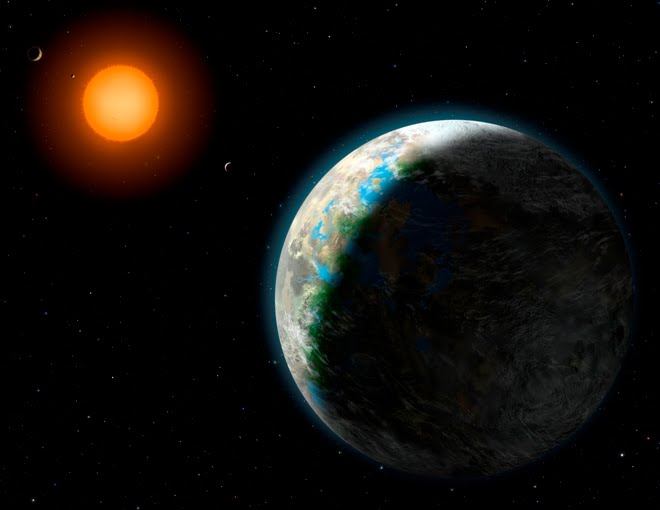Although there is plenty of speculation going around about what will happen on Earth, the movements of astronomical objects are far more predictable, even moreso than clockwork.
In a detailed yet readable 28-page article entitled The Actual Astronomy of 2012, author Thomas Razzeto explains what would be visible in the sky on December 21, 2012, above where the Mayan Priests lived, near Izapa:
What Will Happen on December 21, 2012
Venus will start things off by rising above the horizon at 4:46 AM. It will be extremely easy to see in the black predawn sky and it will lead the sacred tree on its journey across the sky throughout this special day. The fact that Venus will rise before the sun should not be taken lightly with regards to the question of why the Maya picked 2012. Jim Reed, editor of the Institute of Maya Studies’s newsletter, said:
I think it is important that they chose a date of a winter solstice and a
winter solstice when Venus would rise up before the sun. Venus is there
to witness the rebirth.
Yes, of course the Maya would have had a vision that included the planets, especially Venus, which they tracked with a very precise calendar. The Maya were so concerned about Venus that they could even predict when it would pass as a black dot across the face of the sun. This is called a Venus transit and there will be one in June 2012.
Now, let's get back to the unfolding of the day. At 5:11 AM, the moment of the winter solstice will arrive and the sun will be reborn with the days becoming longer. Mercury will rise at 5:23 AM and it will be visible even with dawn's increasing light. It will be the second object on the sacred tree. Next, the sun will enter our world with a blaze of color at 6:29 AM to become the most important object on the sacred tree. Obviously, by this time, the sky will be so bright that both Mercury and Venus will be obscured from view but nonetheless, they will continue their journey across the sky. Pluto, which is never visible to the naked eye, will rise at 7:03 AM and finally Mars will rise at 8:24 AM, making it the last object on the sacred tree. Notice that the sun will rise 103 minutes after Venus and that Mars will rise 115 minutes after the sun. This means that the sun will be close to the middle of these two planets! (10)
A few hours later, at 10:05 AM, the center of the sun will be exactly on the galactic equator. This is the galactic alignment of 2012 and the peak of the celestial love making! This is the moment of cosmic orgasms!
The Actual Astronomy of 2012 and the Sacred Triple Rebirth of the Sun
While the last paragraph above and the article's title may seem hyperbolic, there are gems in this seemingly well-researched piece.
Here are more links related to 2012 astronomy and astronomical research related to 2012:
Understanding Maya concepts of time, by Astronomy Department, Cornell University
Nasa.gov 2012 Astronomy FAQ
Astronomy blog with news on Gliese 581g, Exoplanets, 2012 Transit of Venus, Zarmina's World, exoplanetary exploration, Extreme Supermoons, Kepler telescope, 2012 astronomy, Maya prophecies, links to astronomy websites, 2012 Transit of Venus, 21st century architecture, astronomers, solar energy, astronomical news.
Is There LIFE on Planet GJ581g?
GJ 581 g is an Earth-like planet recently discovered orbiting Gliese 581, a red dwarf star categorized as M Dwarf. This new discovery is perceived by scientists as as a Goldilocks type sphere - not too hot, not too cold. Nicknamed Zarminas World (after his wife Zarmina) by project leader Steven S Vogt, GJ581g will fascinate and enthrall Earthlings for generations to come.
GJ581G Orbiting Gliese 581

Earth Has A Twin
Solar Powered System

Astronomy News Info Photos Telescopes
Chitika Network Links
Astronomy For Everyone
Green Mutual Fund Investing Info
Popular Posts
-
BEIJING -- China plans to launch space labs and manned ships and prepare to build space stations over the next five years, according to a pl...
-
Meteor shower to be obscured by daylight, full moon CAPE CANAVERAL, Fla. -- Heads-up, meteor fans. As many as 750 meteors an hour are expect...
-
To me it seems likely that the Transit of Venus in 2012 is the most obvious reason the Mayan priests would define 2012 as the end of one er...
-
Here are some of the most recent Mars images released by NASA, taken from the Curiosity rover in recent days: Check b...
-
Sustainable Tourism: A Key to Global Solutions by Dr. Reese Halter and Dr. Dave Randle When most people think of tourism, they probably don...
astronomycentral.co.uk
Best Green Stocks Investing Blog
NASA Watch
Subscribe to:
Post Comments (Atom)
GJ581g Zarminas World Info and Links
Search Green Stocks Investing Network

Custom Search



No comments:
Post a Comment